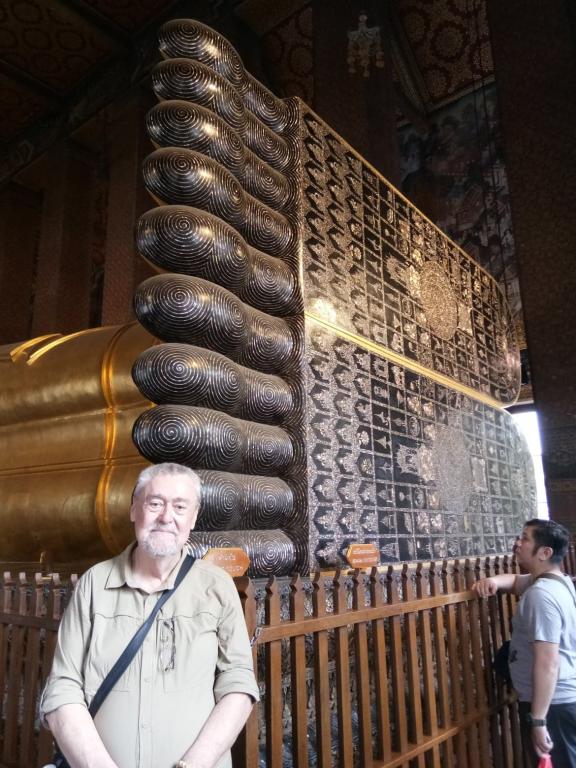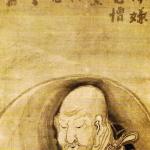
(A dharma talk delivered on October 21st, 2023, during sesshin at the North Carolina Zen Center.)
About five years ago I was contacted by people who ran a spiritual tour group. While they visited several locations around the world, they specialized in trips to Bhutan. They were planning their next trip there and said they were looking for a theme presenter. They asked if I wanted a free trip to Asia. They added it would also include a very modest stipend.
I said no. I had a list of reasons. And each reason seemed sufficient for that no. Wrong location, I’m Zen not Vajrayana. I’m very busy with other projects, I had a book in the works. And, truthfully, I’m beginning to feel my age, and the idea of tramping around the Himalayas seemed, well, over the top. Fortunately for me, they persisted. I consulted some friends and they all said, What’s wrong with you? They’re paying you to go to Bhutan, the place with a Gross National Happiness Index? Take the trip. And so I did.
The trip actually had two parts. We gathered in Bangkok in Thailand for a couple of days. And from there flew to Bhutan. Now, there wasn’t a lot planned for Thailand other than a visit to the royal palace complex to look at the emerald Buddha.
However, as it happened there were two things I actually wanted to do in Thailand, myself. One was to make a pilgrimage to the site where the Christian mystic, social activist, and writer Thomas Merton died. And the other was to go to the site where the English Buddhist writer John Blofeld’s ashes were interred.
Before the trip began I put out feelers to friends and then through a friend of a friend I was put in touch with a retired American professor Joe Shakarchi and his Chinese Thai (if you’re there, the distinction matters) Daru Mongkol.
Out of a love for the Buddhadharma and interspirituality, they facilitated both my hoped for visits. They also said Buddhist Thailand deserved a little more attention than these two personal pilgrimages. They insisted on being my spiritual tour guides for all the three days I had. About the first thing I got to experience was their taking me to Wat Phra Chetuphon Simon Mangkhalaram Rajwaramahawihan, usually best known as Wat Pho. Right in Bangkok, and right across from the Grand Palace.
The monastery complex is a working operation. And there is some serious spiritual tourism there, as among other things it contains the largest collection of Buddhist images in the country. Among those other things the monastery is considered the nation’s oldest public university. It is also a center for traditional medicine, as well as for teaching Thai massage.
Wat Pho is also called the Temple of the Reclining Buddha. That Buddha is worth traveling around the world to see. It’s breathtaking. The reclining image is slightly more than 49 feet high and fractionally more than 150 feet long. It is astonishing to behold.
And. Lying down. And meditation.
Lying down meditating is referenced regularly as one of the four standard meditation postures. Sitting, which is perhaps the baseline, walking is also common, standing, which I’ve seen mostly as a way to stretch the legs during long retreats especially in Kwan Um Zen center practice, and lying down.
There’s always been lying down as an option in the practice communities I’ve sat with. And notice that using the word “sitting” really emphasizes what the baseline is. But lying down has always been an acceptable alternative. Although, for the most part only for people with a health condition that makes sitting on the floor or even in a chair problematic.
Which brings us back to that reclining Buddha at Wat Pho. Of course, that lying down Buddha in Bangkok is a paranirvana image. That is, it’s an icon of the Buddha at the time of his death. Although, I learned Daru and other Thais see it as the Buddha just resting. Not dying. She said it’s a call to take a break once in a while. I kind of loved that pragmatic teaching from popular Buddhist culture.
I’ve long found sacred images can carry multiple meanings. And, well, dying and resting? How goes that line, there’ll be time enough to rest in the grave? These things may not in fact be unconnected.
The biggest difficulty I’ve noticed in meditating while lying down, other than the need for physical space to do it, is that it becomes very, very easy to fall asleep in that posture. I have memories of Zen retreats where a couple of participants needed to lie down, and the gentle snoring that would occasionally waft from their direction.
On the other hand, aside from taking on the practice as one is falling asleep, lying down while meditating, this posture can be powerful. After all the great example for us is the dying Buddha. And I think it’s important to add, the resting Buddha. Assuming a lying down posture carries layers of meaning in the action.
I think of the Buddha’s death. For me there all of those points that arise in the teachings of the old master, come to the fore. At that moment, everything is falling apart. As I look at it as my practice, I see that includes my very self. Often there’s pain involved. Definitely, there are multiple entries into regrets, what ifs, the range of human suffering. For self and for other.
And at the very same time there is an invitation into a peace that passes all understanding. Mahaparinirvana. The great dying. The Sufis say on must learn to die before one dies. And here in this practice dying is woven into the posture itself.
The description of the Buddha’s dying posture is pretty detailed. Lying on one’s right side, legs stretched out. The left hand resting on the left thigh while the right hand is placed under the chin closing the right nostril. I read a Tibetan commentary on this practice where the author, I have no doubt a man, says women should do the opposite. Based, I gather, on tantric theories of energy flow.
Other descriptions of the posture ignore the closing of the nostril entirely. And the old Buddhist descriptions all advise against lying on one’s back. Thoughts of gentle snoring arise.
On another hand there’s a popular adaptation out of the east-meets-east thing that has happened with eastern religions which in Asia would rarely encounter each other, meeting here in the west and influencing each other. As an example many Buddhist meditators adapt the yogic Savasana posture, the “corpse pose.”
In this posture one does lie down on one’s back. The body at rest. Arms along the side with palms up. So, on the side, on the back. With breathing modifications. Without. People take up the practice.
According to the received tradition Gautama Siddhartha, the Buddha of history, was eighty years old when he died. His long life was dedicated to a great search, a finding, and then forty years of teaching. The stories say as he fell with his final illness at Kusinagara, he lay on a bed made for him between two Sala trees, his head facing north, and his face turned to the west. Of course, of course, flowers endlessly bloomed on the trees, falling and replacing magically. At dying, like with birthing, miracles abound.
And. Of course, being who he was, shortly before he died, he delivered a final sermon. Me, I’m interested in what he might have said for a couple of reasons. If one is going to give a summation of one’s life and experience, what better place might it be given than on one’s deathbed?
People have noted this. And some have collected those deathbed sayings. I love Arthur Conan Doyle who said to his wife “You are wonderful.” And Jean-Paul Sartre, who said to his partner Simone de Beauvoir, “I love you very much…” Or, Steve Job’s famously reported, “Oh wow. Oh wow. Oh wow.”
I find myself fascinated with the question, what were the last words of the Buddha? Gasped out of his lying down, dying.
We have two principal versions recording the dying of the Buddha and what he said. The Mahayana version is delicious, a great sermon, lots of miracles. However, in the quest for last words, it actually concludes with him laying down. There is no reference to anything said in the immediate as he faced death with each breath possibly the last.
The Theravada version has some strata of the text which can be reasonably dated from as near as a generation or two from the time of the Buddha. Although, and I believe this is critical, it was not written down until much after the occasion, probably somewhere near the beginning of the common era. So, four or five hundred years after the Buddha died. And it’s written in Pali, a related language to what the Buddha spoke, Magadhi Prakrit, but not his language.
That noted, this is something that probably was critical to many people even at the beginning. When lying there, faced with the last breath, what did the master say? I suspect, I feel, I’m even confident that what we have is probably pretty close to what the dying monk actually shared with his disciples, which was then captured in the Pali canon.
The poet Mary Oliver captured this moment as she wrote:
Slowly, beneath the branches,/He raised his head./He looked into the faces of that frightened crowd.
And what did he say? What could heal the hurt?
“And the Blessed One addressed the bhikkhus, saying: ‘Behold now, bhikkhus, I exhort you: All compounded things are subject to vanish. Strive with earnestness!’”
In another translation:
“Behold, O monks, this is my last advice to you. All component things in the world are changeable. They are not lasting. Work hard to gain your own salvation.”
Lying there, sick, dying, the Buddha’s last words.
One could spend a lifetime unpacking these particular last words. And people have. The “four noble truths” are among those. For me the most successful of these unpackings, is found in the “four seals.”
The formulation of the four seals don’t seem to date much earlier than the The Questions of the Nāga King Sāgara, which itself doesn’t seem to date earlier than the third century before our common era. Which is pretty good, although there’s a good chance it was written much after that.
Of course, it is simply an explicit ordering of what had been taught for years as the heart of the Buddha’s teaching. Quite similar to the four truths, which are seen as foundational in the Theravada. Although its textual appearances are also somewhat controversial. Some scholars seeing linguistic inconsistencies as the list appears in the Setting in Motion the Wheel of the Dhamma Sutta, a version of the Buddha’s first sermon rather than his last. And strongly suspect it is in fact a much later emendation.
That said I believe the four truths and the four seals both seem to me to unpack those last words of Gautama Siddhartha. But the four seals most of all. The teaching within those words uttered while lying on the ground.
The first three are:
First. Impermanence: Everything is made of parts, and they will inevitably come apart. This speaks to the fundamental structures of the universe as well as to the creation of our minds. But it is the impermanence of the mind, it is the impermanent heart that it’s most critical for us to understand. We are real. But we are impermanent.
If we allow ourselves to be present to this truth we discover a response to the longing of our ancestors, to the prayers of our grandfather’s grandfathers.
Second. No-self or the Emptiness of Self: There is no abiding self. The self is real. As I just said, we are real, you and I. Pinch us and we hurt. But our existence is mutable. And in the end, we are mortal. Nothing escapes the dissolution of the body and with it everything we think of as our unique selves. The wonderful mystery that we are, our particular noticing of the universe, our little angle on it all, ends.
When we allow ourselves to be fully present to this, we discover the threads that bind us back to the dreams of our grandmother’s grandmothers, the deep response to their heart’s hurt.
Third. Dis-ease or Disquiet: The motion of things rising and falling is experienced by humans as painful, as anxiety, as anguish. I call this the buzz. The buzz is in the back of everything we encounter, behind every loss, behind every victory.
As we allow this to be what it is, coming generations winding into the great circle as our ancestors and our descendants join at our hearts, and from that place in responding, the way opens.
These first three are sometimes found as a complete list by themselves as the “three marks of existence.” But I find they lack something. And that something is expressed as the fourth seal. Something I believe Gautama Siddhartha taught with every breath, including those last gasping moments in the dirt, between those trees.
Fourth. There is a way through the hurt. This is the good news of Zen Buddhism. While the buzz belongs to the universe, it is simply the experience of everything in motion; the buzz as discomfort, dis-ease, anxiety, or anguish belongs specifically to our human world. Given the size of the cosmos, “human” here would be any being with a consciousness that can discern the first three seals.
Here the longing and the prayers are answered. The response is found in not turning away. It is found within our lives lived and within our deaths dying. The dirt that supports our bodies is itself the product of ages upon ages, of birthing and flourishing and dying. Life created from dust. And returning. Dust to dust. Each of those ages found in the scattering dirt, as the dirt upon which we rest, are revealed as the universe itself. The body of the divine.
There is a way through. Call it enlightenment. Call it awakening. Call it peace.
Telegraphed in the gasping words of a dying monk, lying on the ground, his last breaths carrying a message. Everything falls apart. Pay the deepest attention to this matter. It will save you. It will save the world.
Which brings us back to meditating lying down.
Yesterday as Teshin Sensei had us open the windows, I found my gaze turn just in time to catch the wind picking up a cascade of leaves, like fire dancing around, framed in the windows. Just like those flowers coming into being and falling, surrounding the Buddha as the elements that had gathered and held for eighty years began to dissipate. In the moment when each breath promised no more.
And yet. Like fire. Like falling leaves. Like a gust of wind. The moment the holy spirit itself.
Here we are. In this mysterious rising and falling, loving, hurting, clinging and letting go. Everything in its time. As we lie down.
And each moment of time captured in every other moment.
A Zen koan. An assertion of some profound truth. And an invitation.
As we lie down in meditation, we are joined with the Buddha dying. Or, sometimes, just resting. All of it. All of it.
We lie down, we notice. We attend. We let go.
And the worlds are revealed.














